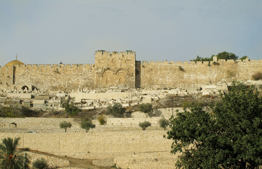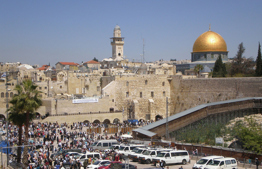Parashat Mishpatim: An Entire Year of Shabbat

Who wished the trees "Gut Shabbos" during shemita year? About shemita, the Shabbat for trees, and those on the margins of society who benefit most. Also: about the three regions of biur and a visit to Kfar Hananya, which divides the Upper and Lower Galilee.
"Six years you shall sow your land and gather in its yield; but in the seventh you shall let it rest and lie fallow. Let the needy among your people eat of it, and what they leave let the wild beast eat …
Six days you shall do your work, but on the seventh day you shall cease from labor, in order that your ox and your ass may rest, and that your bondman and the stranger may be refreshed." (Shemot 23:10-12)
Shabbat Shalom, dear tree!
We're all familiar with the excitement of erev Shabbat. Final preparations, making sure the hotplate or blech is set up and the food that is supposed to be on it is actually there, and that the refrigerator and ern are on Shabbat mode. Everything is in its proper place, all ready to receive the Shabbat Queen. Sometimes this involves a sense of pressure, as we try to get everything in before Shabbat comes in. However, the knowledge that in another few minutes the Shabbat candles will be lit and peace and tranquility rest on the world helps us get through these stressful moments.
Did you ever consider that the earth, trees, and plants have a similar experience? True, it's not every six days; after all, the plant world runs a slower paced life than us restless humans. Yet every seven years the Shabbat Queen comes to visit the world: the Sabbatical year, shemita.
Rabbi Yosef Shlomo Kahaneman was the rosh yeshiva of Ponevezh in Lithuania who following the devastation of the Holocaust reestablished his yeshiva in Bene Berak. It is related that when he would visit the newly founded religious moshavim that meticulously observed the laws of shemita, he would walk through the orchards and wish the trees "Gut Shabbos."
For the needy, bondsman, and stranger
The sanctity of the shemita year is not only manifest on the spiritual level, in a sense of holiness that stems from the near total cessation of working the soil (with certain exceptions permitted during shemita, comparable to piku'ach nefesh for plants). Just like Shabbat, where the ones who enjoy it include—and perhaps are primarily—the simple people on the margins of society, who work hard all week long (and in biblical times this included slaves "bondmen" and converts "strangers," mentioned in the verse), and even the animals—the same was true during the shemita year. One of the goals of shemita mentioned by the verses of our parasha is to allow those who have trouble putting food on the table—not to mention delicious fruit—to partake of the pleasant fruit of the Land of Israel. During this year the fruit is ownerless, and anyone—from the richest of men to the poorest of paupers can equally enjoy the fruit.
Some strive to achieve holiness and spiritually, but think that to achieve this they need to disconnect from people who hinder them from attaining the spiritual heights they seek. The Torah teaches us that the opposite is true: the drive for sanctity—the central purpose of the shemita year—goes hand in hand with the desire to help society's disempowered individuals. Only in this way can we truly achieve sanctity and draw close to G-d.
Three regions of bi'ur
One important law relating to the sacred shemita produce is bi'ur: it is permissible to eat shemita produce as long as it is still growing in the field. After the season is over, one must do bi'ur; that is, remove this produce found at home from one's ownership (declare it hefker, ownerless).
It is not sufficient that a specific fruit be available in some field somewhere in Israel; it has to be available in the same region. For this purpose, the Mishna, Shevi'it (9:2) divides the Land of Israel into three regions: Judea (Central and Southern Israel), Transjordan, and the Galilee. That is, when a certain fruit is no longer available on the trees in Judea, even if it is still growing in the Galilee, Judeans need to do bi'ur on their fruit at home.
Each of these regions are divided into three sub-regions. For instance, the Galilee: Upper Galilee, Lower Galilee, and Tiberius and environs. According to most, there aren't major differences between the sub-regions; that is, if a fruit is still available in the Upper Galilee, Lower Galilee residents may still eat it. Conversely, a Tiberius resident can still eat apples when they are available in local orchards in the Upper Galilee, even if none are left in the Lower Galilee. In contrast, if all the apples are gone in the entire Galilee, but there still are in in the Jerusalem hills—Galileans need to do bi'ur on their apples at home.
Road signs
Where is the boundary between the Upper and Lower Galilee? The Mishna (ibid.) gives us signs, both geographic and botanic. Kfar Hananya is the geographical marker; from there north is the Upper Galilee. Also, from there and north sycamore trees do not grow, since the Upper Galilee is colder and sycamore does not thrive in cold climates. From Kfar Hananya and south is the Lower Galilee, which is also mountainous; however, the mountains are low, so their climate is also warmer and conducive to sycamore tree cultivation.
The Hananya Valley is a branch of the Beit HaKerem Valley. An important road crosses through these two valleys, from Akko on the Mediterranean Coast to Amiad Junction, near the Kinneret. Roads running east to west in Israel are given odd numbers (like Road 1, from Jerusalem to Tel Aviv), while evenly number roads run from north to south (Road 2, Tel Aviv to Haifa). The road through these two valleys is horizontal Road 85. Driving there, one can easily see that while mountains are on either side, those on the southern side are moderately tall, while on the northern side the mountains tower above. From here we can truly understand the words of the Mishna about the difference between the Upper and Lower Galilee.




